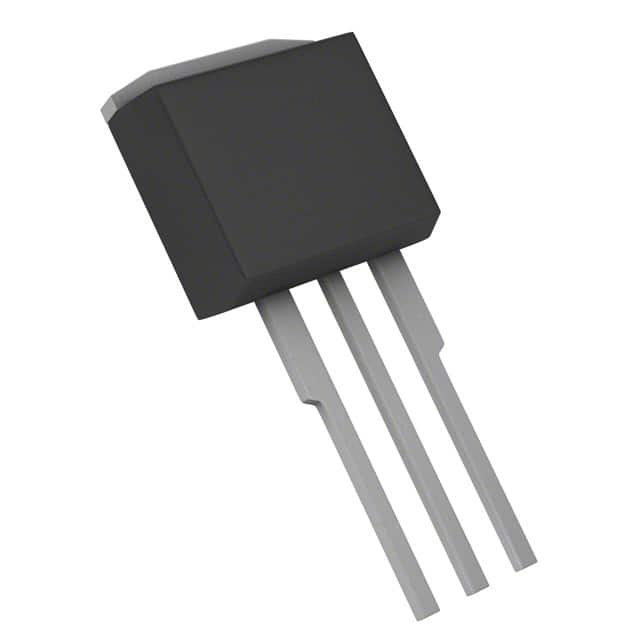IRF540ZL
Introduction
The IRF540ZL is a power MOSFET belonging to the category of electronic components used in various applications. This entry provides an overview of the IRF540ZL, including its basic information, specifications, pin configuration, functional features, advantages and disadvantages, working principles, application field plans, and alternative models.
Basic Information Overview
- Category: Power MOSFET
- Use: The IRF540ZL is commonly used as a switching device in power supplies, motor control, and other high-power applications.
- Characteristics: It exhibits low on-state resistance, high switching speed, and high input impedance.
- Package: TO-262
- Essence: The essence of the IRF540ZL lies in its ability to efficiently control high currents and voltages in various electronic circuits.
- Packaging/Quantity: Typically packaged in reels or tubes containing multiple units.
Specifications
- Drain-Source Voltage (VDSS): 100V
- Continuous Drain Current (ID): 33A
- On-State Resistance (RDS(on)): 0.040Ω
- Gate-Source Voltage (VGS): ±20V
- Power Dissipation (PD): 130W
Detailed Pin Configuration
The IRF540ZL typically has three pins: 1. Gate (G): Controls the conductivity between the drain and source terminals. 2. Drain (D): Connects to the positive supply voltage in most applications. 3. Source (S): Connected to the ground or return path for the load.
Functional Features
- High input impedance allows for easy interfacing with control circuits.
- Low on-state resistance minimizes power dissipation and improves efficiency.
- Fast switching speed enables rapid control of high-power loads.
Advantages and Disadvantages
Advantages
- Low on-state resistance reduces conduction losses.
- High input impedance simplifies drive circuitry.
- Fast switching speed enables efficient control of high-power loads.
Disadvantages
- Susceptible to damage from overvoltage or overcurrent conditions.
- Gate drive requirements may be more critical compared to some alternative devices.
Working Principles
The IRF540ZL operates based on the principle of field-effect modulation of the channel conductivity. When a suitable voltage is applied to the gate terminal, it creates an electric field that controls the flow of current between the drain and source terminals.
Detailed Application Field Plans
The IRF540ZL finds extensive use in the following applications: - Switching power supplies - Motor control circuits - Audio amplifiers - DC-DC converters - Inverter circuits
Detailed and Complete Alternative Models
Some alternative models to the IRF540ZL include: - IRF640 - IRF740 - IRF840 - IRF9540
In conclusion, the IRF540ZL is a versatile power MOSFET with a wide range of applications in high-power electronic circuits. Its low on-state resistance, high input impedance, and fast switching speed make it a popular choice for various switching and control applications. However, users should be mindful of its susceptibility to overvoltage and overcurrent conditions and ensure proper gate drive considerations in their designs.
Word Count: 494
Lista 10 Vanliga frågor och svar relaterade till tillämpningen av IRF540ZL i tekniska lösningar
What is the maximum drain-source voltage of IRF540ZL?
- The maximum drain-source voltage of IRF540ZL is 100V.
What is the continuous drain current rating of IRF540ZL?
- The continuous drain current rating of IRF540ZL is 33A.
What is the on-state resistance (RDS(on)) of IRF540ZL?
- The on-state resistance (RDS(on)) of IRF540ZL is typically 0.044 ohms.
Can IRF540ZL be used for switching applications?
- Yes, IRF540ZL is suitable for switching applications due to its fast switching characteristics.
Is IRF540ZL suitable for use in motor control circuits?
- Yes, IRF540ZL can be used in motor control circuits due to its high current and voltage ratings.
What are the typical applications of IRF540ZL in power electronics?
- IRF540ZL is commonly used in power supplies, motor drives, and DC-DC converters.
Does IRF540ZL require a heat sink for high-power applications?
- Yes, for high-power applications, it is recommended to use a heat sink to dissipate heat effectively.
What is the gate threshold voltage of IRF540ZL?
- The gate threshold voltage of IRF540ZL typically ranges from 2V to 4V.
Can IRF540ZL be used in audio amplifier circuits?
- Yes, IRF540ZL can be utilized in audio amplifier circuits, especially for high-power amplification.
Are there any important considerations when using IRF540ZL in parallel configurations?
- When using IRF540ZL in parallel, it's crucial to ensure proper current sharing and thermal management to avoid uneven stress on the devices.


